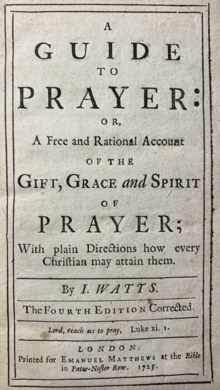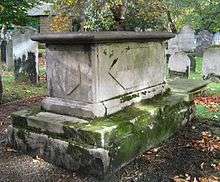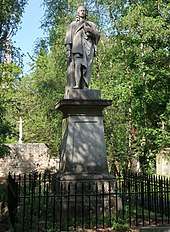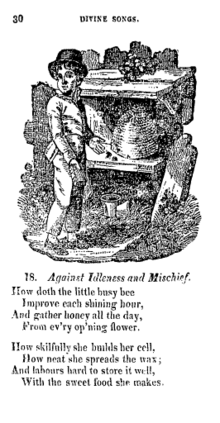Isaac Watts
Isaac Watts (17 July 1674 – 25 November 1748) was an English Christian minister (Congregational), hymn writer, theologian, and logician. He was a prolific and popular hymn writer and is credited with some 750 hymns. He is recognized as the "Godfather of English Hymnody"; many of his hymns remain in use today and have been translated into numerous languages.
Isaac Watts | |
|---|---|
 Portrait by an unknown
artist | |
| Born | 17 July 1674 |
| Died | 25 November 1748 (aged 74) |
| Occupation | Hymnwriter, theologian |
| Known for | "When I Survey the Wondrous Cross", "Joy to the World", "Our God, Our Help in Ages Past" |

Life
Watts was born in Southampton, Hampshire, England in 1674 and was brought up in the home of a committed religious nonconformist; his father, also Isaac Watts, had been incarcerated twice for his views. Watts had a classical education at King Edward VI School, Southampton, learning Latin, Greek, and Hebrew.
Watts displayed a propensity for rhyme from an early age. He was once asked why he had his eyes open during prayers, to which he responded:
A little mouse for want of stairs
ran up a rope to say its prayers.
He received corporal punishment for this, to which he cried:
Watts could not attend Oxford or Cambridge because he was a nonconformist and these universities were restricted to Anglicans—as were government positions at the time. He went to the Dissenting Academy at Stoke Newington in 1690. Much of the remainder of his life centred on that village, which is now part of Inner London.
Following his education, Watts was called as pastor of a large independent chapel in London, Mark Lane Congregational Chapel, where he helped train preachers, despite his poor health. He held religious opinions that were more nondenominational or ecumenical than was common for a nonconformist Congregationalist. He had a greater interest in promoting education and scholarship than preaching for any particular sect.
Watts took work as a private tutor and lived with the nonconformist Hartopp family at Fleetwood House on Church Street in Stoke Newington. Through them, he became acquainted with their immediate neighbours Sir Thomas Abney and Lady Mary. He eventually lived for a total of 36 years in the Abney household, most of the time at Abney House, their second residence. (Lady Mary had inherited the manor of Stoke Newington in 1701 from her late brother Thomas Gunston.)
On the death of Sir Thomas Abney in 1722, his widow Lady Mary and her unmarried daughter Elizabeth moved all her household to Abney House from Hertfordshire, and she invited Watts to continue with them. He particularly enjoyed the grounds at Abney Park, which Lady Mary planted with two elm walks leading down to an island heronry in the Hackney Brook, and he often sought inspiration there for the many books and hymns that he wrote.
Watts lived at Abney Hall in Stoke Newington until his death in 1748; he was buried in Bunhill Fields. He left an extensive legacy of hymns, treatises, educational works, and essays. His work was influential amongst nonconformist independents and religious revivalists of the 18th century, such as Philip Doddridge, who dedicated his best-known work to Watts.

Watts and hymnody
Sacred music scholars Stephen Marini, Denny Prutow and Michael LeFebvre describe the ways in which Watts contributed to English hymnody and the previous tradition of the Church. Watts led the change in practice by including new poetry for "original songs of Christian experience" to be used in worship, according to Marini.[3] The older tradition was based on the poetry of the Bible: the Psalms. According to LeFebvre, Psalms had been sung by God's people from the time of King David, who with a large staff over many years assembled the complete book of Psalms in a form appropriate for singing (by the Levites, during Temple sacrifices at the time). The practice of singing Psalms in worship was continued by Biblical command in the New Testament Church from its beginnings in Acts through the time of Watts, as documented by Prutow. The teachings of 16th-century Reformation leaders such as John Calvin, who translated the Psalms in the vernacular for congregational singing, followed this historic worship practice.[4] Watts was not the first Protestant to promote the singing of hymns; however, his prolific hymn writing helped usher in a new era of English worship as many other poets followed in his path.[5]
Watts also introduced a new way of rendering the Psalms in verse for church services, proposing that they be adapted for hymns with a specifically Christian perspective. As Watts put it in the title of his 1719 metrical Psalter, the Psalms should be "imitated in the language of the New Testament."[3] Besides writing hymns, Isaac Watts was also a theologian and logician, writing books and essays on these subjects.
Logic

Watts wrote a textbook on logic which was particularly popular; its full title was, Logick, or The Right Use of Reason in the Enquiry After Truth With a Variety of Rules to Guard Against Error in the Affairs of Religion and Human Life, as well as in the Sciences. This was first published in 1724, and it was printed in twenty editions.
Watts wrote this work for beginners of logic, and arranged the book methodically. He divided the content of his elementary treatment of logic into four parts: perception, judgement, reasoning, and method, which he treated in this order. Each of these parts is divided into chapters, and some of these chapters are divided into sections. The content of the chapters and sections is subdivided by the following devices: divisions, distributions, notes, observations, directions, rules, illustrations, and remarks. Every contentum of the book comes under one or more of these headings, and this methodical arrangement serves to make the exposition clear.
In Watts' Logic, there are notable departures from other works of the time, and some notable innovations. The influence of British empiricism may be seen, especially that of contemporary philosopher and empiricist John Locke. Logic includes several references to Locke and his Essay Concerning Human Understanding,[6] in which he espoused his empiricist views. Watts was careful to distinguish between judgements and propositions, unlike some other logic authors. According to Watts, judgement is "to compare... ideas together, and to join them by affirmation, or disjoin then by negation, according as we find them to agree or disagree".[7] He continues, "when mere ideas are joined in the mind without words, it is rather called a judgement; but when clothed with words it is called a proposition".[8] Watts' Logic follows the scholastic tradition and divides propositions into universal affirmative, universal negative, particular affirmative, and particular negative.
In the third part, Watts discusses reasoning and argumentation, with particular emphasis on the theory of syllogism. This was considered a centrally important part of classical logic. According to Watts, and in keeping with logicians of his day, Watts defined logic as an art (see liberal arts), as opposed to a science. Throughout Logic, Watts revealed his high conception of logic by stressing the practical side of logic, rather than the speculative side. According to Watts, as a practical art, logic can be really useful in any inquiry, whether it is an inquiry in the arts, or inquiry in the sciences, or inquiry of an ethical kind. Watts' emphasis on logic as a practical art distinguishes his book from others.
By stressing a practical and non-formal part of logic, Watts gave rules and directions for any kind of inquiry, including the inquiries of science and the inquiries of philosophy. These rules of inquiry were given in addition to the formal content of classical logic common to textbooks on logic from that time. Watts' conception of logic as being divided into its practical part and its speculative part marks a departure from the conception of logic of most other authors. His conception of logic is more akin to that of the later, nineteenth-century logician, C. S. Peirce.
Isaac Watts' Logic became the standard text on logic at Oxford, Cambridge, Harvard and Yale, being used at Oxford for well over 100 years. C. S. Peirce, the great nineteenth-century logician, wrote favourably of Watts' Logic. When preparing his own textbook, titled A Critick of Arguments: How to Reason (also known as the Grand Logic), Peirce wrote, 'I shall suppose the reader to be acquainted with what is contained in Dr Watts' Logick, a book... far superior to the treatises now used in colleges, being the production of a man distinguished for good sense.'[9]
Watts followed the Logic in 1741 by a supplement, The Improvement of the Mind. This also went through numerous editions and later inspired Michael Faraday. It was also widely used as a moral textbook in schools.
Legacy, honours and memorials



On his death, Isaac Watts' papers were given to Yale University in the Colony of Connecticut, which nonconformists (Puritans/Congregationalists) had established. King Edward VI School, Southampton, which he attended, named one of its houses "Watts" in his honour.
The Church of England and Lutheran Church remember Watts (and his ministerial service) annually in the Calendar of Saints on 25 November, and the Episcopal Church on the following day.
The earliest surviving monument to Watts is in Westminster Abbey; this was completed shortly after his death. His much-visited chest tomb at Bunhill Fields dates from 1808, replacing the original that had been paid for and erected by Lady Mary Abney and the Hartopp family.[10]
Another early memorial may be lost: a bust to Watts commissioned on his death for the London chapel with which he was associated. The chapel was demolished in the late 18th century: remaining parts of the memorial were rescued at the last minute by a wealthy landowner for installation in his chapel near Liverpool, but it is not known whether the bust survives. Another bust is installed at the nonconformist Dr Williams's Library, in central London.
The first public statue stands at Abney Park, where Watts lived for more than 30 years at the manor house, and where he also died. The park later became Abney Park Cemetery, opened in 1840; and the statue of Watts was erected here by public subscription in 1845. It stands in Dr Watts' Walk, in front of the Abney Park Chapel, and was designed by the leading British sculptor, Edward Hodges Baily. A scheme for a commemorative statue on this spot had been promoted in the late 1830s by George Collison, who in 1840 published an engraving as the frontispiece of his book about cemetery design in Europe and America, and at Abney Park in particular. Collison's proposal was never commissioned, and Baily's design was adopted instead.
A later, rather similar statue was also funded by public subscription and erected in a new Victorian public park named after Watts in Southampton, the city of his birth. In the mid-nineteenth century, the Congregational Dr Watts Memorial Hall was built in Southampton and also named after him. It was lost to redevelopment after the Second World War, but the Isaac Watts Memorial United Reformed Church was built on the site.
In 1974, the City of Southampton commemorated the tercentenary of Watts' birth by commissioning the biography Isaac Watts Remembered, written by David G. Fountain, who like Watts, was a nonconformist minister from Southampton.
Cultural or contemporary influences
One of Watts' best-known poems was an exhortation "Against Idleness and Mischief" in Divine Songs for Children. This was parodied by Lewis Carroll in the poem "How Doth the Little Crocodile", included in his book Alice's Adventures in Wonderland. His parody is better known than Watts' original poem. The poem was also featured in the segment on the cartoon programme "Rocky and His Friends" called "Bullwinkle's Corner", in which Bullwinkle Moose recites poetry. In this case, the poem was titled "The Bee", with no author credit.
In his novel David Copperfield (1850), Charles Dickens has school master Dr. Strong quote from Watts' "Against Idleness and Mischief".
The 1884 comic opera Princess Ida includes a punning reference to Watts in Act I. At Princess Ida's women's university, no males are allowed. Her father King Gama says that "She'll scarcely suffer Dr. Watts' 'hymns'".
A poem often referred to as "False Greatness" by Joseph Merrick ("The Elephant Man"), which was used in writing or "signature block" by Merrick, starting "Tis true, my form is something odd but blaming me, is blaming God..." is often (incorrectly) quoted or cited as a work by Isaac Watts. In fact only the last few sentences were penned by Watts ("False Greatness", book II-Horae lyricae 1743) starting "Mylo, forbear to call him bless'd That only boasts a large estate..."[11]
Works
Books
- Horae Lyricae: Poems, Chiefly of the Lyric Kind (2nd ed. 1709)
- Guide to Prayer (1715; 4th ed. corr 1725)
- Psalms of David: Imitated in the Language of the New Testament, and Apply'd to the Christian State and Worship(1719)
- Logick: or, the Right use of Reason in the Enquiry After Truth, with a Variety of Rules to Guard Against Error in the Affairs of Religion and Human Life, as Well as in the Sciences (1726)
- The Strength and Weakness of Human Reason: or, the Important Question about the Sufficiency of Reason to Conduct Mankind to Religion and Future Happiness, Argued Between an Inquiring Deist and a Christian Divine: and the Debate Compromis'd and Determin'd to the Satisfaction of Both (1731)
- Faith and Practice: Represented in Fifty-Four Sermons on the Principal Heads of the Christian Religion: Preached at Berry-street, 1733 (1739)
- The Improvement of the Mind: or, a Supplement to the Art of Logick: Containing a Variety of Remarks and Rules for the Attainment and Communication of Useful Knowledge, in Religion, in the Sciences, and in Common Life (1741)
- Vol 1 Vol 2 at The Internet Archive (1768, 1773, 1787 edition)
- The Knowledge of the Heavens and the Earth Made Easy ..., first edition, 1726; 1760 edition at Google Books
- The Doctrine of the Passions – Explain'd and Improv'd, [fifth edition] (1795)
- A Short View of the Whole Scripture History: With a Continuation of the Jewish Affairs From the Old Testament Till the Time of Christ; and an Account of the Chief Prophesies that Relate to Him
- Watts is thought to be the author of the tract: An Essay on the Freedom of Will in God and Creatures (copy on The Internet Archive).
- Divine Songs Attempted in Easy Language for the Use of Children (1715)
Hymns
Watts' hymns include:
- Joy to the World (based on Psalm 98, tune by an unknown composer using fragments from Handel, first published in England in 1833, popularized by American Lowell Mason)
- Come ye that Love the Lord (often sung with the chorus [and titled] "We’re marching to Zion")
- Come Holy Spirit, Heavenly Dove
- Jesus Shall Reign Where’er the Sun (based on Psalm 72)
- Our God, Our Help in Ages Past (based on Psalm 90)
- When I Survey the Wondrous Cross
- Alas! and Did My Saviour Bleed
- How Sweet and Aweful Is the Place
- This Is the Day the Lord Hath Made
- 'Tis by Thy Strength the Mountains Stand
- 'When I Can See My Title Clear
- I Sing the Mighty Power of God (originally entitled Praise for Creation and Providence from Divine Songs Attempted in Easy Language for the Use of Children)
- My Shepherd Will Supply My Need (based on Psalm 23)
- Bless, O My Soul! the Living God (based on Psalm 103)
Many of Watts' hymns are included in the Anglican Hymns Ancient and Modern, the Oxford Book of Common Praise, the Christadelphian hymnal, the Episcopal Church's Hymnal 1982, Evangelical Lutheran Worship, the Baptist Hymnal, the Presbyterian Trinity Hymnal, and the Methodist Hymns and Psalms. Many of his texts are also used in the American hymnal, The Sacred Harp, using what is known as the shape note notation used for teaching non-musicians. Several of his hymns are used in the hymnals of the Church of Christ, Scientist and The Church of Jesus Christ of Latter-day Saints.
See also
- Africa (William Billings)
- Congregational church
- English Dissenter
- Independent (religion)
- Puritan
Notes
- Mable, Norman, Popular Hymns and their Writers, p. 179.
- Boreham, F. W. (1945), A Late Lark Singing, p. 29.
- Marini 2003, p. 76.
- Marini 2003, p. 71.
- Marini 2003, p. 76 lists hymn writers who followed in the tradition established by Watts, including Charles Wesley, Edward Perronet, Ann Steele, Samuel Stennet, Augustus Toplady, John Newton, William Cowper, Reginald Heber, Samuel Davies, Timothy Dwight, John Leland, and Peter Cartwright.
- Watts 1825, p. 14.
- Watts 1825, p. 115.
- Watts 1825, p. 117.
- Peirce, C. S. (1933) The Collected Papers of Charles Sanders Peirce, vol. II, Paul Weiss and Charles Hartshorne, eds. Cambridge MASS, Harvard University Press
- Historic England. "Monument to Isaac Watts, East Enclosure (1396517)". National Heritage List for England. Retrieved 24 February 2014.
- Watts, Isaac, The Poems of Isaac Watts, Volumes 44–46, Press of C. Whittingham, 1822, p. 193.
References
- Jones, J. A., ed. (1849). Bunhill Memorials: sacred reminiscences of three hundred ministers and other persons of note, who are buried in Bunhill Fields, of every denomination. London: James Paul. pp. 298–304.
- Marini, Stephen A. (2003). Sacred Song in America: Religion, Music, and Public Culture. Urbana: University of Illinois Press.CS1 maint: ref=harv (link)
- Thorncroft, Michael (1958). "The Fertile Soil; The Church is Built; The Early Years (1714–1758); The Age of Richard Price; New Causes for Old; The Ideal of Service; The Lights Go Out; The Present Day". Trust in Freedom: The Story of Newington Green Unitarian Church 1708–1958. Privately printed for church trustees..
- Watts, Isaac (1825). Logic or the Right Use of Reason in the Inquiry After Truth; with a Variety of Rules to Guard Against Error in the Affairs of Religion and Human Life, as well as in the sciences (reprint ed.). US: Kessinger.CS1 maint: ref=harv (link).
External links
| Wikiquote has quotations related to: Isaac Watts |
| Wikisource has original works written by or about: Isaac Watts |
| Wikimedia Commons has media related to Isaac Watts. |
- Isaac Watts at the Eighteenth-Century Poetry Archive (ECPA)
- Works by Isaac Watts at Project Gutenberg
- Works by or about Isaac Watts at Internet Archive
- Works by Isaac Watts at LibriVox (public domain audiobooks)

- Works by Isaac Watts at Post-Reformation Digital Library
- A Solemn Address to the Great and Ever Blessed God (1802), originally published as A Faithful Inquiry after the Ancient and Original Doctrine of the Trinity (1745)
- The Isaac Watts Fan Club at the Wayback Machine (archived 27 October 2009) background info and midi files
- Hymns by Isaac Watts
- O God our help in ages past (school hymn of King Edward VI School, Southampton, Watts' alma mater)
- Isaac Watts Remembered (David G. Fountain, 1974) Biography commissioned by Southampton City Council (his home city) to commemorate 300 years of his birth (ISBN 978-0903556576)
- Monergism.com Isaac Watts Links to works of Isaac Watts
- Logic by Isaac Watts
- Improvement of the Mind by Isaac Watts
- The Harmony of all the Religions which God ever Prescribed to Men and all his Dispensations towards them by Isaac Watts
- The Ruin and Recovery of Mankind by Isaac Watts
